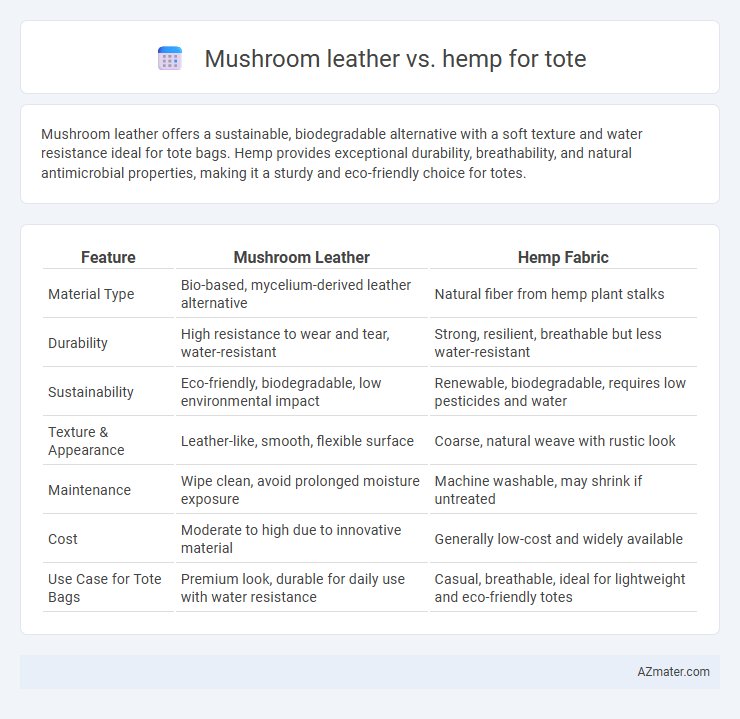Mushroom leather offers a sustainable, biodegradable alternative with a soft texture and water resistance ideal for tote bags. Hemp provides exceptional durability, breathability, and natural antimicrobial properties, making it a sturdy and eco-friendly choice for totes.
Table of Comparison
| Feature | Mushroom Leather | Hemp Fabric |
|---|---|---|
| Material Type | Bio-based, mycelium-derived leather alternative | Natural fiber from hemp plant stalks |
| Durability | High resistance to wear and tear, water-resistant | Strong, resilient, breathable but less water-resistant |
| Sustainability | Eco-friendly, biodegradable, low environmental impact | Renewable, biodegradable, requires low pesticides and water |
| Texture & Appearance | Leather-like, smooth, flexible surface | Coarse, natural weave with rustic look |
| Maintenance | Wipe clean, avoid prolonged moisture exposure | Machine washable, may shrink if untreated |
| Cost | Moderate to high due to innovative material | Generally low-cost and widely available |
| Use Case for Tote Bags | Premium look, durable for daily use with water resistance | Casual, breathable, ideal for lightweight and eco-friendly totes |
Introduction: Mushroom Leather and Hemp as Sustainable Alternatives
Mushroom leather, derived from mycelium, offers a biodegradable and renewable alternative to traditional leather, combining durability with eco-friendly production processes. Hemp, known for its fast growth and minimal need for pesticides, provides a sustainable fabric option that is strong, lightweight, and highly resistant to wear. Both materials contribute to reducing environmental impact, making them popular choices for eco-conscious tote bags.
Material Origins: Understanding Mushroom Leather and Hemp
Mushroom leather is derived from mycelium, the root structure of fungi, offering a sustainable and biodegradable alternative to traditional leather. Hemp, sourced from the stalks of the Cannabis sativa plant, is prized for its durability and eco-friendly cultivation requiring minimal water and pesticides. Both materials prioritize renewable origins, with mushroom leather emphasizing fungal biomass cultivation and hemp relying on fast-growing plant fibers for eco-conscious tote production.
Environmental Impact of Production
Mushroom leather production significantly reduces environmental impact by utilizing agricultural waste and requiring minimal water and chemicals, resulting in lower carbon emissions and biodegradability. Hemp cultivation demands less water and pesticides than conventional cotton, supports soil health through phytoremediation, and captures carbon efficiently, making it a sustainable fiber choice. Choosing between mushroom leather and hemp for tote bags hinges on prioritizing biodegradable fungal materials versus renewable, eco-friendly plant fibers, both offering substantial benefits over synthetic alternatives.
Durability and Longevity of Tote Bags
Mushroom leather offers moderate durability with resistance to wear and tear but tends to have a shorter lifespan compared to traditional materials due to its biodegradable nature. Hemp fibers provide superior strength and longevity, making tote bags highly durable and capable of withstanding heavy use and frequent washing. Choosing hemp for tote bags ensures extended usability, while mushroom leather prioritizes sustainability with a trade-off in long-term durability.
Aesthetic Appeal and Design Versatility
Mushroom leather offers a unique, organic texture and rich earthy tones that elevate the aesthetic appeal of tote bags with a luxurious and sustainable look. Hemp provides a natural, coarse weave that delivers a rugged yet minimalist style, prized for its durability and eco-friendly qualities. Design versatility is enhanced in mushroom leather through its ability to mimic traditional leather finishes, while hemp excels in customizable patterns and colors, making both materials suitable for distinct fashion statements.
Biodegradability and End-of-Life Solutions
Mushroom leather offers superior biodegradability compared to hemp, breaking down naturally within weeks without releasing harmful residues, making it an eco-friendly choice for tote bags. Hemp, while durable and renewable, decomposes more slowly and may require industrial composting facilities for effective end-of-life processing. Both materials contribute to reducing plastic waste, but mushroom leather's rapid biodegradation provides a more sustainable solution for minimizing environmental impact.
Cost Efficiency and Market Availability
Mushroom leather offers a higher cost efficiency compared to hemp for tote production due to lower processing expenses and faster material growth cycles. Hemp, while durable and eco-friendly, often incurs higher cultivation and manufacturing costs, impacting overall pricing. Market availability favors hemp with established supply chains and widespread use, whereas mushroom leather is emerging with limited but rapidly expanding production capacity.
Comfort and User Experience
Mushroom leather offers a soft, supple texture that enhances comfort and provides a lightweight feel ideal for tote bags, while its breathability minimizes moisture buildup during extended use. Hemp, on the other hand, is known for its durability and natural stiffness, offering a sturdy structure but potentially less comfort when carrying heavy loads over long periods. Users seeking a blend of eco-friendly materials and comfortable ergonomics often prefer mushroom leather for its flexible, skin-friendly qualities.
Ethical Considerations: Animal-Free and Cruelty-Free Choices
Mushroom leather and hemp both offer ethical alternatives for tote bags, emphasizing animal-free and cruelty-free production processes. Mushroom leather, derived from mycelium, eliminates animal suffering and reduces reliance on traditional animal hides, while hemp is a sustainable plant-based fiber grown without harmful pesticides. Choosing these materials supports eco-friendly fashion by minimizing harm to animals and promoting environmentally responsible harvesting practices.
Future Prospects: Innovations in Sustainable Tote Materials
Mushroom leather and hemp are rapidly gaining traction as innovative sustainable materials for tote bags due to their eco-friendly properties and biodegradability. Advances in mycelium cultivation techniques are enhancing the durability and texture of mushroom leather, making it a competitive alternative to traditional animal leather. Hemp's fast growth cycle and high fiber strength offer a renewable resource with minimal environmental impact, positioning both materials at the forefront of the future sustainable fashion movement.

Infographic: Mushroom leather vs Hemp for Tote
 azmater.com
azmater.com